
Subscribe to continue reading
Subscribe to get access to the rest of this post and other subscriber-only content.


Subscribe to get access to the rest of this post and other subscriber-only content.
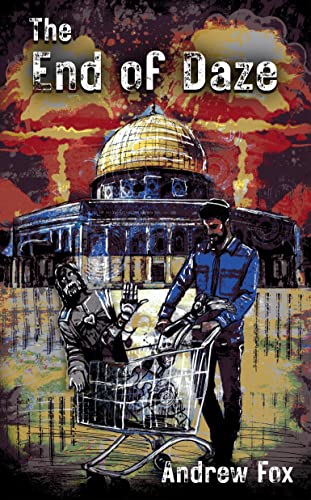
It’s only been a wait of a dozen years, but one of my personal favorites of my books, The End of Daze, has just been published in paperback and ebook formats by Madness Heart Press. Finally! It came out under their imprint Aggadah Try It, which is a specialty imprint focused on science fiction, fantasy, and horror of Jewish interest.
In essence, my novel is a satirical Jewish version of the Left Behind series that answers the question, “What if the End of Days arrives and the traditional Jewish version is the accurate one?” As you may imagine, chaos ensues, with the other, much larger world faiths being very unhappy, particularly those followers of Islam — and the progressive elements of the Jewish community are among the biggest critics of G-d’s reemergence onto the scene.
Here’s the back cover copy:
“Jacob Zvi has turned his back on everything he was taught to value. His faith, his family, his citizenship, and even his morals. Yet seemingly divine fate introduces Jacob to the struggling members of an Orthodox congregation in the middle of a ghetto in New Orleans while terrorists explode a purloined Soviet nuclear artillery shell atop the Temple Mount in Jerusalem.
“But things quickly take a turn for the Biblical, for the worthy dead are returning to life to build a Third Temple atop the now radioactive Temple Mount, scoured empty by the atomic blast. They return not to bodies of flesh and blood, but to cybernetic bodies produced in an advanced robotics lab on the Tulane campus, part of a secret project funded by the Department of Homeland Security.
“The End of Days has begun, but unlike anything that has been anticipated by Christian, Buddhist, Hindu, or Muslim. When Jacob is inexplicably selected to serve as God’s mouthpiece, and he finds he makes for a clownishly awkward prophet of God’s Kingdom on Earth.
“But he will have to up his game immeasurably in order to broker peace with all the factions who bitterly reject this version of the End Times—chief among them progressive Jews themselves! THE END OF DAZE is a science fiction eschatological satire fitting for the End Times encroaching on the twenty-first century.”
You can purchase a paperback copy for $14.95 or an ebook for $4.99 from Amazon:
And here is the full wraparound cover for the paperback:
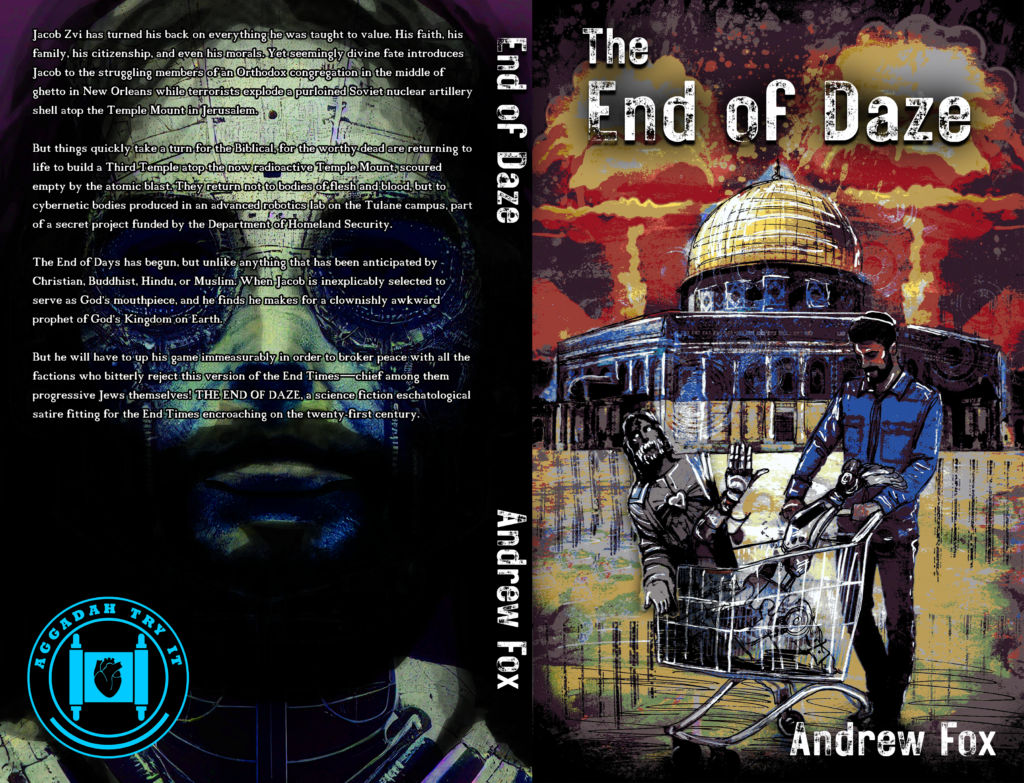
Another Katrina anniversary. Another storm. This one, thank heaven, a dwarf in destructive power compared with its infamous predecessor.
Even as a relatively weak Category One hurricane, however, Isaac is proving to be troublesome. Some of the most destructive storms to hit the Gulf Coast have been low-velocity but slow-moving storms, such as this one, which cling to an area for days, dumping tens of inches of rain. Already, Isaac has disrupted power to nearly half a million residents in the Greater New Orleans area. The improved Corps of Engineers flood protection system seems to be working well thus far, with only one minor glitch concerning pumping facility controls at the Seventeenth Street Canal, near the border between Orleans and Jefferson Parishes, which has been corrected. Down south, in Plaquemines Parish, near where the storm made landfall, a stretch of parish-built levees have been overtopped, not breached, and the entry of water on the east bank of the Mississippi has flooded an undetermined number of homes with up to nine feet of flooding.
Until three years ago, my family and I lived in a house on the West Bank of the Mississippi, in a suburban portion of New Orleans called Algiers. That area of the city lucked out during Katrina, not being in the East Bank flood zone. However, had Katrina made landfall fifteen or twenty miles west of where it landed, the West Bank’s levee system, then (and most likely still) greatly inferior to the East Bank’s, would likely have crumbled before the force of the storm surge, and my neighborhood would have been underwater. A flood map from The Times Picayune showed the severity of potential flooding on the West Bank, neighborhood by neighborhood. My block could have received up to nine feet of water. My house stood about four feet above the level of the street, on a slightly raised lot, so we could have returned home from South Florida, where we had taken shelter, to find five feet of water in our house.
My mother-in-law and cousins still live in Algiers. Dara and I have many friends in the New Orleans area. Many of them are without power at this point, and Isaac will stay in the area for another full day, continuing to dump rain and lash the city with wind gusts of up to a hundred miles per hour. Please keep the good folks of the Gulf Coast in your thoughts.
Here’s the beginning of an article I posted one year ago today:
“Six years ago, on another Monday, August 29th, Hurricane Katrina, a Category Three storm pushing a Category Five storm surge, slammed into coastal Mississippi. For the first twelve hours after landfall, the city of New Orleans appeared to have avoided the worst. But then the levees designed to hold back Lake Pontchartrain began breaking — the Industrial Canal levee, the 17th Street Canal levee between Metairie and the western parts of New Orleans, the London Avenue Canal levee adjacent to the Gentilly neighborhood, and the Mississippi River-Gulf Outlet levees that had been meant to protect Chalmette and St. Bernard Parish. Within a day, eighty percent of the City of New Orleans had flooded, and nearly all of St. Bernard Parish was underwater. At least 1,836 people died along the Gulf Coast, most from the flooding, making Katrina the deadliest storm in U.S. history since the 1928 Lake Okeechobee Hurricane in South Florida, when approximately 2,500 people were killed.”
Following Katrina, I worked to rebuild the devastated Lousiana Commodity Supplemental Food Program, which lost three of four food warehouses and three-quarters of its vehicles in the storm and the post-storm flooding. I then worked two-and-a-half years with FEMA, part of a management team hired to introduce some program management vigor to the problem-plagued Temporary Housing Program.
I believe it was just a month or two ago that I read that the last FEMA trailer in Southeastern Louisiana had finally been vacated. And now they may have to start in all over again, at least with some folks down in Plaquemines Parish.
I worked in New Orleans’ Central Business District for nearly twenty years. For the first fifteen I worked at the old State Office Building on Loyola Avenue, surrounded by City Hall, Charity Hospital, the Main Downtown Branch of the New Orleans Public Library, and the Downtown/Superdome Holiday Inn, formerly the Howard Johnson’s. Later I worked for the Federal Emergency Management Agency’s (FEMA) Gulf Coast Recovery District, then the Louisiana Transitional Recovery Office, headquartered at 1250 Poydras Street, at the corner of Poydras and Loyola Avenue.
So I have a lot of personal history with that area. A work trip brought me back this past week to 1250 Poydras, to support some sessions of computer training for federal field agents. Some things hadn’t changed, as some things seem to never change in New Orleans. Other things had changed quite a lot.
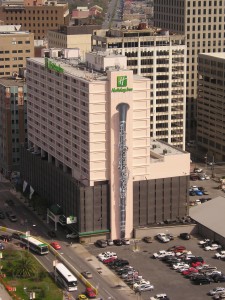
The Downtown/Superdome Holiday Inn, famous for its clarinet mural; once, when a Howard Johnson's, infamous for being the site of a sniper's rampage
Things that haven’t changed? The Downtown/Superdome Holiday Inn where I used to park while working at the Office of Public Health still has its eighteen-story tall mural of a clarinet and its garage level murals of the Faubourg St. Mary neighborhood as it appeared just before the Civil War. Before it became a Holiday Inn, it was a Howard Johnson’s, infamous as the site of Mark Essex’s killing spree on January 7, 1973. Essex, a member of the Black Panthers, carried out his first killings a week earlier, on New Year’s Eve, 1972, when he murdered two police officers with a sniper’s rifle. On January 7, he invaded the Howard Johnson’s, killed two white tourists at random and shot the manager and assistant manager of the hotel; both died. Essex died himself from at least one of nearly two hundred gunshot wounds he suffered on the roof of the hotel, as he engaged in a gun battle with police overhead in a Marine helicopter and sharp shooters stationed on the roofs of adjacent high rises (one of which is currently in the process of being demolished; it is the derelict white building, minus all its windows, behind the current Holiday Inn; it used to be a fashionable office building, then an apartment building, but it has stood derelict and abandoned as long as I can remember). For the full story of Mark Essex’s life and murderous rampage, check out A Terrible Thunder: the Story of the New Orleans Sniper, by journalist Peter Hernon.
A row of nineteenth century commercial buildings still stands at the corner of South Rampart and Gravier Streets, behind the Holiday Inn. I used to walk past them every weekday on my way to lunch at a bagel shop on Carondolet Street (I read the New Yorker article on a pair of rival liposuctionists which inspired me to write The Good Humor Man, or, Calorie 3501 at that bagel shop). They were unused then, twenty years ago. They are still unused today. Handsome buildings. I wish someone would figure out something to do with them (aside from demolish them for surface parking lots, which that side of downtown is full of).
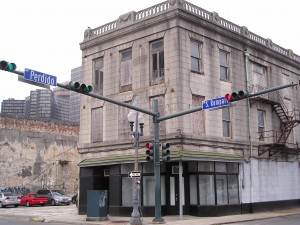
The intersection of Perdido Street and South Rampart Street, one of the few remaining buildings significant to the early history of jazz
Then there’s the building at the corner of Perdido and South Rampart Streets — the home of the Eagle Saloon and Oddfellow’s Hall, perhaps the most important surviving building in the history of early jazz music in New Orleans. Buddy Bolden, Louis Armstrong, and Buddy Petit all played there. All of the building’s neighbors have been demolished, so it sits like an island of musical and cultural history, gathering dust. Back when I was working in the neighborhood, the empty building sported signs announcing that it would soon be restored as part of a jazz museum and cultural center. The signs came down sometime after Hurricane Katrina. Now it just sits there, empty, with apparently no renovation plans afoot, in danger of becoming yet another surface parking lot.
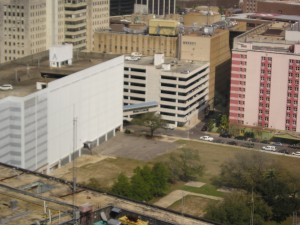
That empty rectangle between the white parking garage and the trees of Duncan Plaza is where I worked for fifteen years
The things that have changed? Some of the things I remember are now gone. I spent so much time at the State Office Building on Loyola Avenue, headquarters for the Louisiana Office of Public Health, between 1992 and Hurricane Katrina that the old 1950s government building felt like a second home. I applied for two marriage licenses on the building’s first floor. I organized the New Year Coalition to stop holiday gunfire and wrote portions of my first four horror and science fiction novels either in the building or in coffee shops and food courts within a block or two of my office. After the levees broke following Hurricane Katrina, the tunnel that connected the State Office Building with Charity Hospital a block away flooded. The flooding caused the water pressure in my building to surge, resulting in all the toilets and sinks on the first four floors overflowing for several weeks. One of my first duties upon returning to New Orleans after the storm was to help evacuate the stricken building of all essential equipment and files. The State Department of Health and Hospitals did nothing to try to save the building from mold and decay while they negotiated with FEMA regarding having the federal agency pay for demolition and construction of a new state office building. After four years of wrangling, FEMA agreed to pay for the demolition, but not for reconstruction. My old department now plans to lease space in an office tower adjacent to the Superdome that is owned by Saints owner Tom Benson. The old building was in the process of being demolished when I left New Orleans in the summer of 2009. Now its footprint is an empty slab of concrete and grass, which I was able to look down upon from the training room I visited on the twenty-third floor of the 1250 Poydras building. It was a disorienting feeling to look down on an empty space where so much of my adult life had unfolded. This was once Louis Armstrong’s childhood neighborhood. Most of its homes were torn down to construct the city’s government center. Now portions of the government center are coming down… to be replaced with what? I’m sure many in city and state government now wish they would have preserved the Armstrong family home.
I remember a stately row of nineteenth century commercial storefronts on Common Street between South Rampart Street and University Place, one of which had been the first photography studio owned by an African-American photographer in New Orleans. Its last commercial use, if I remember right, had been a shoe store. A few years before I left the city, when the building’s owner announced it would be demolished (to be replaced by a parking garage, of course), there was a push in the historic preservation community to have it declared a landmark, but the effort failed. There is no garage there now, just an empty patch of grass… and one of the strangest public artworks I’ve ever come across, a group of French Quarter-style street lamps twisted together into a giant street lamp tarantula.
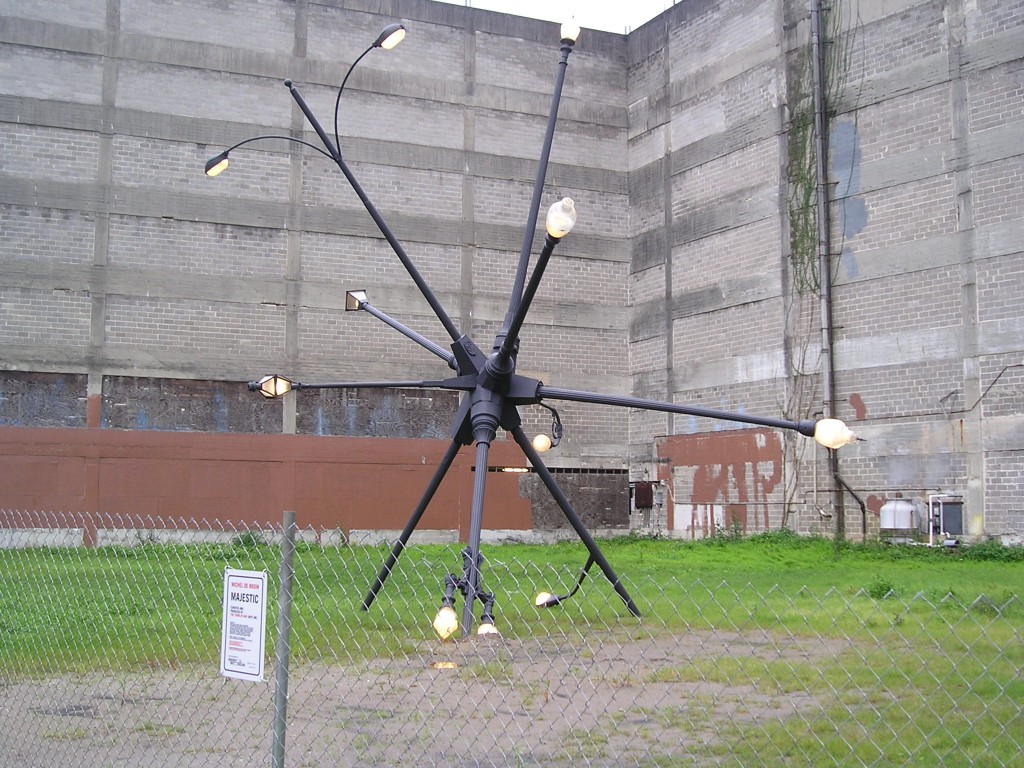
There used to be a late nineteenth century block of storefronts on this lot; now there's a patch of grass and a street lamp tarantula
A few things in the neighborhood have changed for the better. The old Kress Five and Dime Store, underutilized or empty for a number of years, is now home to Ritz Carlton Hotel. The wonderful old Joy Theater reopened this past December; once the largest movie theater on Canal Street, it is now a performing arts venue. Canal Street now boasts a handsome International House of Pancakes, probably the most attractive restaurant in the entire chain.
Some things which haven’t changed since I moved away are things I wish would change, however — like the Orpheum Theater across the street from the Roosevelt Hotel where I stayed, once the home of the New Orleans Symphony, which flooded after Hurricane Katrina and now sits defaced with graffiti, or the Saenger Theater, whose renovation and reopening have been stalled by bureaucratic red tape and political infighting. I hope the Joy (and perhaps the Saenger across the street) can be a catalyst for the redevelopment of the western/lake side of downtown Canal Street, which appears more neglected, shoddy, and abandoned than at any other time I can remember.
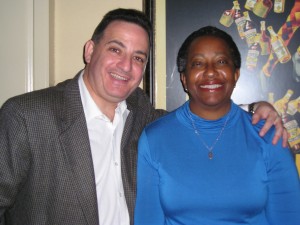
Me with Marian Moore, New Orleans science fiction writer and the Krewe de Jieux's Jewish American Princess for 2012
The best things that remain for me in New Orleans, though? Those would be my friends. I enjoyed dinners with several of my oldest friends from my time in the city, including Dr. Leslie Lyons, with whom I attended Loyola, Kat B. Kay, fellow science fiction fan and congregant at Shir Chadash, and Marian Moore, one of the longest serving members of George Alec Effinger’s writing critique group, and an impressive science fiction writer in her own right. I miss all of my New Orleans friends very much, and I’m fortunate that my work allowed me to pay some of them a visit. Maybe the next time I go down I’ll be able to bring my boys, all of whom were born in the Crescent City. Asher, in fact, was born on the Saturday before Fat Tuesday; we nearly named him Endymion, because the parade traffic that snarled the Mid-City and Broadmoor neighborhoods almost kept us from reaching Baptist Hospital in time for Dara to deliver. The 2012 Endymion parade rolled two days after I returned to Virginia this past week, on a rainy Saturday.
This week I’ll be back down in New Orleans for work, and I’m fortunate enough to be staying at the historic Roosevelt Hotel in the heart of the Central Business District, on Baronne Street just off world-famous Canal Street. During the twenty-one years I lived in the city, the hotel was known as the Fairmont. Built in 1893 as the Grunewald Hotel, the building received a 400-room annex in 1908, then was renamed the Roosevelt Hotel in 1923 to honor President Teddy Roosevelt, who had stayed at the hotel on a number of occasions. In 1965, its name was changed yet again, this time to the Fairmont Hotel. In August, 2005, the hotel’s basement and a number of its guest rooms were flooded with ten feet of water from Lake Pontchartrain following Hurricane Katrina’s rupture of the flood protection levees. The building sat vacant for four years, until it was restored and reopened as part of Hilton’s Waldorf Astoria group in June, 2009.
Dara and I used to have late-night dinners at the Fairmont’s casual restaurant, Bailey’s, which had a great Manhattan vibe (and which served up terrific lox and onion omelettes, one of the only places in New Orleans that offered them). I used to take peeks in the Sazerac Bar and the Blue Room after a meal at Bailey’s or while walking through the hotel’s annual Christmas Wonderland display. The Blue Room, opened in 1935, played host to Louis Armstrong, Frank Sinatra, Tony Bennett, Marlene Dietrich, and Sonny and Cher, among many famous names. Here’s an entertaining story on the many entertainers who played the Blue Room (which is now open again). Here are some other wonderful images of the Blue Room over the decades.
One fact about the Grunewald/Roosevelt Hotel which I hadn’t been aware of prior to putting together this post was that the hotel hosted America’s first nightclub, The Cave. The Cave was opened in 1908 as part of the hotel’s expansion and was located in the basement, one level below where the Blue Room would open in 1935. Meant to make visitors feel like they were dining in Kentucky’s Mammoth Cave, The Cave featured full-size stalactites, stalacmites, and grotto fountains populated by naked nymphs. This reportedly took 700,000 pounds of plaster to accomplish. Many early jazz bands played The Cave until it was closed in 1930 and the space was turned into the hotel’s laundry. Postcards of The Cave show an unearthly dining room, akin to a set from Georges Melies’ pioneering science fiction film A Voyage to the Moon. For your viewing pleasure, ladies and gentlemen, may I present The Cave…
Here are some other Roosevelt Hotel links you may enjoy:
Great old photographs of the Roosevelt Hotel
The story of the connection between the Kingfish, Governor Huey P. Long, and the Roosevelt Hotel
Evocative images from the Grunewald/Roosevelt Hotel’s early days, including a stay by Elvis during the making of King Creole
Facinating story on the restoration of the Katrina-damaged Fairmont Hotel into the Roosevelt Hotel
Another article on the reopening of the Roosevelt Hotel, this one from USA Today
An article on The Roosevelt Review, the hotel’s house organ, published from 1937 to 1968, filled with articles on New Orleans written by local historians
One last thing–I stumbled upon a photograph of Sharkey Bonano (in the hat, playing the trumpet) and His Kings of Dixieland playing the Blue Room in 1955. Back when I was living on Tchoupitoulas Street and then Constance Street in Uptown New Orleans, I used to do all my writing at the CC’s Coffeehouse at Jefferson Avenue and Magazine Street. That’s where I wrote Fat White Vampire Blues. One of the regulars at CC’s was an elderly gentleman who used to sing for his coffee. He’d serennade patrons who expressed interest in hearing an old standard, and they’d pay him by buying him a cup of coffee or a muffin. Really nice old fellow. He used to talk all the time about his friend Sharkey, the bandleader, who he used to sing with back in the 1960s. He talked about him like he was a father or an older brother, often with tears in his eyes as he remembered.
Yes, indeed, I know what it means to miss New Orleans…
Not that life in Northern Virginia has been bad. Far from it. In some key ways, life has improved for my family since our move. But no other place can fully replace New Orleans – its people, its neighborhoods, its music, its festivals, its profusion of places to hang out and simply be. I tell people that life is just bigger in New Orleans than it is in other places; the highs there are much loftier than average, and the lows there are very, very low. It is a very romantic place to live. Fabulously fun if you’re single and have few responsibilities; tough as hell if you’re trying to raise a family.
So what’s changed in the past two years?
Everywhere I drove, the streets are getting torn up and remade. General de Gaulle in Algiers on the West Bank. Loyola Avenue and South Rampart Street downtown. South Carrollton Avenue in Uptown. The treacherous old Huey B. Long Bridge over the Mississippi, connecting Elmwood and Bridge City, built during the Depression, is at last being upgraded to the standards of the latter half of the twentieth century (always a terror to drive across due to its narrow lanes, built for the cars of 1935, maybe it’ll be less stomach-shriveling a couple of years from now). Several new library branches are finally replacing old libraries that got flooded out during the Katrina disaster. I saw one going up in my old neighborhood, at the edge of Village Aurora in Algiers, still a steel skeleton but at least progressing. All good news; the tail end of all that FEMA money is finally reaching the streets.
Oak Street in Carrollton is bustling, busier and more full of shops and restaurants than I’ve ever seen it before; it reminds me of what the section of Magazine Street between Louisiana and Washington Avenues used to look like, funky and colorful (before it went a little too upscale). Boutique du Vampyre has moved from Orleans to Toulouse in the French Quarter, gaining a little space in the transition. My favorite “big girls” stripper bar in the Quarter is now a memory, the place where it was on Decatur in the Quarter empty and forlorn-looking. The Maple Street Children’s Books Shop is also gone, apparently done in by the Uptown Borders Books during its brief, two-year existence on St. Charles Avenue. There are now designated bicycle lanes on Carrollton Avenue and St. Charles Avenue.
What hasn’t changed in the past two years?
P.J.’s Coffee on General de Gaulle still serves a great cup of joe, and the gals behind the counter there are still pretty and friendly. Airline Highway (yes, I know it’s been renamed Airline Drive, but I’ll always think of it as Airline Highway) still retains its beat up used cars lots and seedy motels. Octavia Books is still one of the country’s best independent bookstores. More Fun Comics is still more fun than your average comics shop. Kim Son Vietnamese Restaurant still has a menu it would take you a year to sample every item from if you ate one item per visit and went five times a week. The streets throughout New Aurora in Algiers are still in crappy shape and will bust out your transmission and your muffler if you drive over them faster than twenty miles per hour. It is still almost impossible to eat a bad meal in the French Quarter (you can if you try, but you have to really try). The derelict bowling alley on the West Bank Expressway across from the Quality Inn (formerly the Clarion Inn, formerly the Holiday Inn) is still derelict, but all the small businesses in the shabby shopping center surrounding it still seem to be doing a surprisingly darn good business, including Pho Tau Bay Restaurant and Barry Manufacturing (where I bought a terrific sports coat for my birthday). The fire station at the corner of Shirley Avenue and General de Gaulle in Algiers still doesn’t have a repaired roof, more than six years after Hurricane Katrina, despite being only blocks away from the site of the former FEMA Louisiana Transitional Recovery Office.
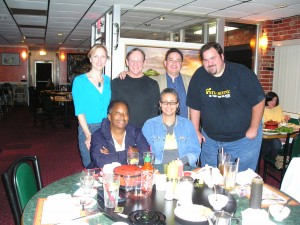
Birthday dinner at Kim Son: standing are Gwen Moore, Fritz Ziegler, me, and Rob Cerio; seated are Marian Moore and Cherie Cerio
Something else that hasn’t changed? The wonderful willingness of strangers to enter into conversations, and of friends to spend hours talking in any reasonably accommodating space. I reconnected with many old friends during my visit – Fritz Ziegler, Marian Moore, Marc McCandless, Diana Rowland, and Gwen Moore from my old writing workshop group, the one founded by George Alec Effinger back in 1988; and Gulf Coast and Southern fandom friends such as Maxy Pertuit, Frank Schiavo, Raymond Boudreau, Allan Gilbreath, Lee Martindale, and Rebecca Smith. I also made some wonderful new friends at CONtraflow – John Guidry, Michael Scott, Dean Sweatman, Rob and Cherie Cerio, Jennie Faries, and Kalila Smith.
But one of the most endearing and unique qualities of New Orleans and the surrounding region is that you are perfectly capable of meeting (and very likely to meet) new friends, or at least very friendly acquaintances, virtually anywhere you go. I stopped in for a quick lunch at a little French Quarter luncheonette on Dauphine Street where I used to go when I worked at FEMA downtown, only noticing that it had a new name and new ownership after I’d sat down and looked at the menu. I ended up enjoying one of the best sandwiches I’ve ever had the pleasure of putting in my mouth – a redfish slider with dill mayo – and a great conversation with the owner, Billy, who had opened the place, Nosh, only a year earlier. I wanted to buy myself a sport coat to replace one I’d torn a hole in and ended up at Barry Manufacturing at 95 West Bank Expressway, across from my convention hotel. I used to be in sales myself (I sold Saturn cars and trucks for a brief time), so I appreciate a sales job done right. Alphonse at Barry did me right; I saw one jacket I fell in love with, but it fit me like a glove, with no give whatsoever, and Alphonse was honest enough to tell me I’d have problems if I so much as gained a pound. He didn’t have the same jacket one size bigger, darn it, but I liked his stock, and I liked his prices, I liked him, so I looked until I found another jacket I liked almost as much, and that fit me much better. Sale!
And then there was Coffee &, a little coffee and donut shop on Manhattan Boulevard in Marrero that I’d driven past hundreds of times when I lived on the West Bank. I’d never gotten around to stopping in there, even though I’m a big coffee drinker; I think their tinted windows sort of put me off, making me dubious of what I’d find if I opened their door. But Saturday morning I found myself in their strip center and hungry for breakfast and desperate for coffee, so I said, “What the hell?” And you know what? I loved the place! As soon as I walked in and saw the counter and the counter staff and the selection of donuts and the signs listing the breakfast specials, I said to myself, “Ooohh, nice, I like this joint…” I sat at the counter near the door into the kitchen, where I could watch the staff mix the batter for the donuts. I got scrambled eggs and hash browns and coffee (with endless refills, of course) for less than five bucks. Plus, I had a super time kibitzing with the staff. You know you’re in a good spot when one of the customers sitting next to you is an employee, there during her own time, who came in for coffee and breakfast because she likes the place and loves the people who work there. A neat bonus was that Coffee & sells coffee travel mugs exactly of the type I’ve been looking for – all plastic, so safe for the microwave, with a sturdy closable top that won’t leak on me. Liked ‘em so much I bought two to bring back to Virginia with me (the second one for Dara, who deserved a new coffee mug).
My only disappointments with my trip were that I wasn’t able to bring my family down with me – all three of my boys were born in New Orleans – and that I couldn’t squeeze in more time to visit with my mother-in-law and my cousins than I did. And there were old favorite bookstores and coffeehouses I didn’t get to. I’ll just have to find excuses for more trips, I guess. The place still feels like home, and I suspect it always will.
A big tip of a ten-gallon hat to CONtraflow 2011 con chair Rebecca Smith, guest liaison Raymond Boudreau, and the entire convention team for pulling off a very successful maiden event, the first fan-sponsored science fiction convention in the New Orleans area since Hurricane Katrina in 2005. Paid attendance was around 300, not bad at all for an event in its first year. Although not advertised as such, the convention had the feel of a weekend-long relaxicon, where formal programming took a back seat to schmoozing, kibitzing, and catching up with old friends.
One opportunity I was extremely happy to be able to take advantage of was to personally thank many fans involved in Gulf Coast fandom, organizers of either CoastCon or MobiCon, for the marvelous and spirit-maintaining support they offered to my family and me during the difficult months following Hurricane Katrina. Despite having suffered monumental personal losses and setbacks themselves, a group of Gulf Coast fans made it their project in September and October of 2005 to track down every fan, writer, and artist they could from the Gulf Coast region to make sure they had made it through the disaster, and to provide encouragement, support, and care packages. My family and I were sheltering in a friend’s uncle’s empty condo down in Surfside, Florida when we received the first of two boxes that had been packed for us by the Gulf Coast fans — vegetarian groceries for Dara and me, and baby care items for our two infant boys. With all the help we received from friends and family (all detailed in the Afterword to The Good Humor Man, or, Calorie 3501), this was the gesture and the effort that touched me the most deeply, and one of the aspects of Katrina I find myself talking about most often.
I heard stories from several longtime New Orleanian fans of what they had lost in the storm. One new friend, comics aficionado Dean Sweatman, told me he’d lost his entire collection of Golden Age and Silver Age comics. Unable to replace them, he’s taken to collecting scans of classic comics from the Internet. I shared my reminiscences of Jack Stocker, fan and book dealer at many local conventions, who’d lost about ten thousand books when his house flooded with nine feet of water. Jack, in his eighties at the time, had borne up under this loss with remarkable grace and optimism and had immediately begun building up his collection of books again, filling the closets of his new apartment in Faubourg Marigny behind the French Quarter, looking forward to selling at regional conventions again. I believe he was still making his book-buying rounds until right before he died.
About half of my formal programming events failed to come off as planned, but it ended up not being much of a big deal, since I always had good company to tide me through (at one panel on Sunday, the other two participants were called away by emergencies, so I ended up talking for much of the hour with an attendee whose grandmother had received food boxes from the senior citizens’ nutrition program I administered for many years in Louisiana). In addition to three discussion panels, I had two readings scheduled, one on Friday and the other on Saturday. I don’t think I was alone among con guests in having their readings attended by either zero or one audience member; readings didn’t turn out to be a popular event-type for the crowd that showed. But on Friday I enjoyed a fun one-on-one chat with Michael “Scotty” Scott, the gaming guest of honor, who, seeing me sitting alone in a function room, took pity on me and ended up telling me a whole bunch about the VulCons of the 1970s in New Orleans and the various games he has designed.
And on Saturday, instead of reading a selection from Fire on Iron, I was able to continue a long conversation with John Guidry, dean emeritus of New Orleans fandom and chair of the 1988 World Science Fiction Convention in New Orleans (NolaCon 2), who told me a boatload of wonderful stories about his friendships and encounters over the years with such genre luminaries as Leigh Brackett, Johnny Weissmuller, Harlan Ellison, Donald A. Wollheim (Guest of Honor at NolaCon 2), and Ray Harryhausen, as well as local New Orleanian friends we had shared in common, the late Jack Stocker and the much-missed George Alec Effinger. With John, I got matters rolling with a question or two and then just shut my trap and listened. His tales of writers and fans in New Orleans stretched all the way back to Depression-era encounters between H. P. Lovecraft, Robert E. Howard, and New Orleans resident E. Hoffmann Price, as well as the legendary Mississippi River raft trip taken by Edmund Hamilton and Jack Williamson to meet Price in the Crescent City. I learned many, many things about the VulCons, Crescent City Cons, and New Orleans Science Fiction and Fantasy Fairs of yore, plus inside dope on the logistical and financial challenges of running a WorldCon. He also told me a great story about how he’d pulled off his successful bid for the 1988 WorldCon — he’d convinced a number of comely young women fen (and one male fan) to dress as harlequins in the party suite, including one young lady who would grow up to become one of the most prominent editors in the science fiction field (hint: she was a guest at CONtraflow).
One of my most pleasant tasks at the convention was to serve as a judge for the costume contest. It was small, with five children and three adults participating, but the kids were all cute and excited, and two of the adult participants had constructed outstanding outfits — an eight-foot-tall werewolf and a zombie Lego man. One of the other judges, Jennie Faries, was a master costumer with lots of WorldCon experience, and the third, the Mysterious Margoli, was a one-time horror hostess from the Jackson, Mississippi area. Had a great time talking old monster movies with her. My old friend Diana Rowland, most recently author of My Life as a White Trash Zombie, and I spent an enjoyable hour together discussing “White Trash Supernaturals.” I moderated another panel on Saturday, “Our Vampires are Different,” and was very pleased to share the stage with Victor Gischler, who received the plum assignment from Marvel Comics of completely revamping (if you’ll pardon the pun) the vampire corner of the Marvel Universe. We talked some about our shared love of Gene Colan’s and Marv Wolfman’s classic Tomb of Dracula series, and I had a chance to clue the audience in on the unacknowledged greatness of the Blacula films. Another highlight for me was my birthday dinner at Kim Son Vietnamese Restaurant, joined by Rob and Cherie Cerio and my old writing workshop buddies Marian Moore, Fritz Ziegler, and Gwen Moore.
But I think my best memories of the con will end up being the time I spent with Ray Boudreau, with whom I share a birthday and a birth year, enthusiastically talking about the TV, cartoon, and movie-watching experiences and convention-going fun we have in common from our childhoods; my chance to do an interview with Scotty as part of his New Orleans fan history project; and the stories I heard from John Guidry. John revealed the very warm, very human sides of a couple of my favorite writers. I always had the impression of Ray Bradbury as being a splendidly happy and grateful man, and John confirmed this for me. Leigh Brackett was one of Ray’s earliest supporters, giving him invaluable encouragement during the years when he was writing his earliest stories and publishing them in Planet Stories. John told me that Leigh had mentioned once that Ray either called or wrote to Leigh every single day for decades to tell her how much he loved her and appreciated her. John also shared an anecdote about Edmund Hamilton, Leigh Brackett’s husband, one of my favorites of the early pulp writers. Ed had written a couple of hundred novellas and novelettes for the Captain Future pulp during the 1940s. John was present when a young boy approached Ed at a convention to tell him how much he’d loved the Captain Future stories. John said he’d watched Ed interact with the little boy, and Ed had treated the youngster like he’d been the only other person in the room, listening with rapt attention. You can’t beat hearing stories like that about a couple of your idols. Thanks, John. You helped make my weekend in New Orleans a memorable one.
I’ll be heading down to the Big Easy tomorrow (Thursday) to be a guest at CONtraflow, the first science fiction convention to be hosted in the Greater New Orleans area since a month before Hurricane Katrina hit the region in August, 2005. This will be my first visit to my former home town since my family and I picked up stakes in 2009. I’ll be staying through Sunday.
They’ve got me pretty tightly scheduled at the convention, but I’ll also have time to be out and about. I plan to stop by Octavia Books in the Uptown neighborhood to sign some books, and I’ll probably pay Marita at Boutique du Vampyre in the French Quarter a visit, too. I’ll have Thursday afternoon and evening free to get together with friends. If you need to reach me, use the contact form on my Contact Me page here on the website; Dara will make sure I get your message.
Here’s my con schedule:
Friday, Nov. 4, 5-6 PM: I’ll be reading from The Good Humor Man, or, Calorie 3501, celebrating that book’s reissue as an ebook (and my birthday, by the way).
Friday, Nov. 4, 6-6:30 PM: Opening Ceremony
Friday, Nov. 4, 6:30-8 PM: Meet the Guests Party
Friday, Nov. 4, 10-11 PM: Panel discussion on “White Trash Supernaturals” with my old friend and workshop partner, paranormal suspense writer Diana Rowland
Saturday, Nov. 5, 1-2 PM: I’ll be moderating a panel discussion entitled “Our Vampires are Different,” with Kurt Amacker, Charles Gramlich, Victor Gischler, and Kalia Smith.
Saturday, Nov. 5, 6-8 PM: I’ll be one of the judges for the Costume Contest (first time I’ll be judging; should be interesting!).
Saturday, Nov. 5, 10-11 PM: I’ll be reading from Fire on Iron, my Civil War steampunk horror-adventure novel.
Sunday, Nov. 6, 11-12 noon: Panel discussion on “The Importance of Place in Science Fiction” with Lou Antonelli and Kurt Amacker
Other panels I’ll attempt to attend (I’m notoriously bad at actually being present where I say I’m going to be at conventions, generally spending much more time hanging out in the Dealers’ Room than I intended to) include: “History of New Orleans Fandom;” “Transhumanism Today” (with Guest of Honor David Brin); Toni Weisskopf’s Baen Books Panel; “Ebooks: Is This the Future of Publishing?”, “The Business of Writing;” “Apocalypse Fiction;” “Writing for the Young Adult Crowd;” “Keeping It Real: Being Accurate in Fiction” (presented by Diana Rowland, who used to be a small-town forensic examiner); and “How Not to Get Published” (gee, I should be presenting that panel, considering my growing pile of unsold manuscripts).
I’m looking forward to seeing how the old town is doing, dropping by former haunts, and seeing my mother-in-law (really, I am). I just wish timing and finances would’ve allowed me to bring Dara and the kids, too.
Six years ago, on another Monday, August 29th, Hurricane Katrina, a Category Three storm pushing a Category Five storm surge, slammed into coastal Mississippi. For the first twelve hours after landfall, the city of New Orleans appeared to have avoided the worst. But then the levees designed to hold back Lake Pontchartrain began breaking — the Industrial Canal levee, the 17th Street Canal levee between Metairie and the western parts of New Orleans, the London Avenue Canal levee adjacent to the Gentilly neighborhood, and the Mississippi River-Gulf Outlet levees that had been meant to protect Chalmette and St. Bernard Parish. Within a day, eighty percent of the City of New Orleans had flooded, and nearly all of St. Bernard Parish was underwater. At least 1,836 people died along the Gulf Coast, most from the flooding, making Katrina the deadliest storm in U.S. history since the 1928 Lake Okeechobee Hurricane in South Florida, when approximately 2,500 people were killed.
Thank God Hurricane Irene wasn’t worse than it was. The worst effects of Irene appear to be the delayed effects, the post-storm swelling of rivers and streams. Vermont, where Irene swept through as a tropical storm, looks to be suffering the worst flooding. Seeing the photos of homes inundated with rushing water brought back a lot of memories. Those folks in Vermont and New Jersey and the flooded portions of Philadelphia are going to have many tough months ahead of them. Water is a terrible destroyer of homes, far worse than high winds. Winds may leave many beloved possessions behind, still salvageable. Water, and the mold growth it induces, rots one’s possessions and turns them to foul, stinking garbage. It’s an awful thing to witness.
My family and I were stranded in Albuquerque, New Mexico six years ago. We’d flown out with our two baby sons and four days’ worth of clothing and medicines to attend the Bubonicon science fiction convention and to visit my parents. We weren’t able to return to our home in New Orleans for almost two months. We had the great fortune that our house was located on the west bank of the Mississippi, in a different flood plain from the majority of New Orleans, and so was spared the flooding that devastated over a hundred thousand homes. But had the storm made landfall just fifteen miles more to the west, it would have been our levees that breached, and our neighborhood would have been inundated with up to nine feet of water.
My hopes go out to all those folks who will be rebuilding after a flood. It is heartbreaking, backbreaking, stinking work. But somehow, it gets done.
I’ve posted an article I wrote called “Crossing the River Styx,” which was about my return to New Orleans six weeks after the levees broke. It originally appeared in Moment Magazine in April, 2006. The congregations I describe in the article have all rebuilt and are once more thriving, six years on.
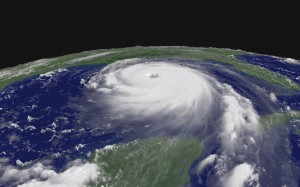
What did Hurricane Katrina have to do with my obsession for vintage laptops? Quite a bit, as things turned out. Yes, we’ve reached the end of Vintage Laptop Computer Madness Week here at Fantastical Andrew Fox.com. While Hurricane Katrina did not directly destroy or drown my vast collection of vintage machines, it set in motion a complex series of events in my family’s lives that ultimately led to the dissolution of the majority of my ponderous accumulation. Where most of my machines ended up, however, remains a mystery…
I present, for your reading pleasure, the final installment of “Lust for a Laptop, or the Madness of the Compulsive Collector.”
For the convenience of those of you just discovering this novella-length memoir of my writing life at the dawn of the Portable Computing Age, I’ve placed links to all six installments below.
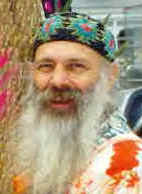
I added the only Fat White Vampire short story I’ve ever written, “Jules Versus Breezy,” which also serves as a little memorial piece for my very dear friend, Robert Borsodi. To me, Bob was one of the people who made New Orleans such a fantastical, enchanting place. He had operated bohemian coffeehouses in ten different locations by the time he arrived in New Orleans in the late 1970s; he’d founded his first in New Haven in 1959, when he’d been a student at Yale, before he went into the Marines (it is so very, very hard for me to imagine Bob Borsodi in the United States Marines; but Bob, like Walt Whitman, contained multitudes). He opened his first New Orleans coffeehouse on Daneel Street, next door to what was then the Penny Post and is now the Neutral Ground Coffeehouse, a folk music club. His second, best known location was on Freret Street, about a half mile east of Tulane and Loyola Universities. It was a huge, warehouse-like space, with the espresso bar in front and a stage in back big enough for full scale plays. Bob lived in a kind of hidden alcove above the stage, with access to the building’s roof. The entire coffeehouse served as a colossal collage, an ever-evolving art installation made up of whatever Bob and his regulars felt like gluing to the walls and furniture. I first met Bob in 1983, while I was an undergraduate at Loyola, shortly after I moved into an apartment in the neighborhood. I did my laundry at a shabby little washateria next to Bob’s place, and while I was waiting for my wash to finish, I’d go next door for a cup of tea or an Italian soda and a chat with Bob. He didn’t have his beard then, and he was open during the afternoons, which he wasn’t in later years, although the place was mostly deserted before about seven at night. He was interested in Loyola because he thought his son might attend. We got to be pretty good friends over the next three years. Upon graduation, I swore to him that I intended to move back to New Orleans someday. I don’t think he believed me.
The next time I saw Bob was after I moved to Northport, New York in Long Island’s Suffolk County. Bob had taken a crew of his friends and regulars to perform one of his plays, Musk, at Theater for the New City in the East Village in Manhattan. The stage set looked just like Borsodi’s Coffeehouse in New Orleans. I immediately felt homesick. I invited Bob and his lady friend, Sara Beth, to come stay with me at my apartment in Northport. They stayed the night and walked around the harbor and the old downtown. I promised again that I would move back to New Orleans someday. Again, I don’t think Bob believed me.
Less than two years later, I picked myself up and plunked myself back in New Orleans, with no plans or prospects other than finishing my first novel. . . at Borsodi’s Coffeehouse. Bob was really the one who drew me back to New Orleans. So I have much to thank him for, since everything that is most wonderful in my life has its roots in my time in New Orleans. I’ll write more about my return to New Orleans and my experiences at Borsodi’s Coffeehouse in an essay I’m finishing up called “Lust for a Laptop, or the Madness of the Obsessive Collector.”
I wrote the little story here linked to in 1998, for Bob’s sixtieth birthday. Four years later, suffering from incurable cancer that had spread through much of his body, in unbearable pain, Bob threw himself off the Hale Boggs Bridge in Luling, about thirty miles west of New Orleans. The city hasn’t quite been itself since.